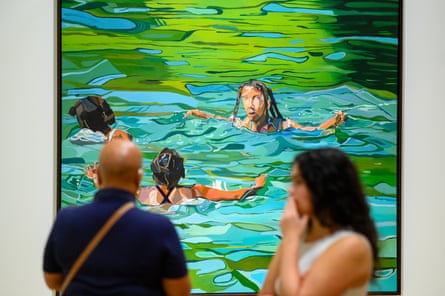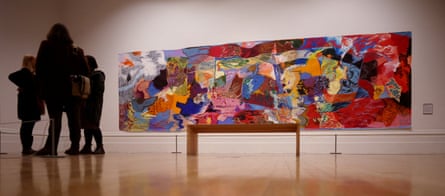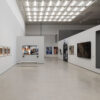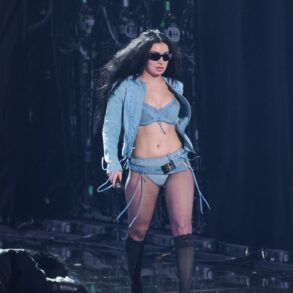Artist and curator Sumuyya Khader sits on the wooden benches of the Walker Gallery in Liverpool and scans the room. “We are surrounded by deceased white males,” she says, laughing while pointing out the portraits and landscapes on the walls around and above us.
“I was always told when I was younger to look up,” she adds. “But you get to the point where you look up and think these histories are so torrid. I want people to go in, hear the beat and the bass and be like, ‘Ohhhhh!’”
Khader is talking about Conversations, the Walker’s new landmark show that features more than 40 Black female and non-binary artists. The first part of the show that greets you is a sound rather than a physical piece as the pugilistic beats of Jamaican dancehall blast through the galleries.
It’s a work by Zinzi Minott called Bloodsound, a wall of transparent speakers filled with red liquid made from sugar – a reminder that the low-end frequencies and melodies of reggae aren’t just entertainment but the legacy of a much older struggle.

It plays an immersive soundtrack stitched together from more than 200 samples: songs from Jamican music legends such as Marcia Griffiths are interspersed with field recordings from Notting Hill carnival, an interview with Minott’s grandmother – a former nurse – a few weeks before she died, and a speech by Nye Bevan about the creation of the NHS. “I didn’t want it to feel like a party,” says Minott. “There are bits where you recognise the song but then it cuts … you can’t get too lost in it.”
It’s an intense introduction to an exhibition that’s trying to do things differently.
Conversations’ origins are rooted in a shameful discovery: out of the Walker’s 13,000-piece collection only two were by Black female artists, a bust created by Edmonia Lewis in 1872 and Lubaina Himid’s 1983 work We Will Be. Many British institutions would find a similar dearth (although places such as Cartwright Hall in Bradford purposefully began collecting Black British art in the 1970s) but in Liverpool – a city with the oldest settled Black community in the UK – the lack of representation was particularly jarring.
Khader knows all about that history. She grew up in Liverpool 8, the postcode that is still home to Black families that can trace their lineage back to the 18th century. But she didn’t want the show to be one that only looked back.




Artists from the Black Arts Movement of the 1980s are on show, including Maud Sulter, Claudette Johnson and Himid, but they sit alongside a new generation of artists including Joy Labinjo and Olivia Sterling whose Lincoln Sausages painting imagines turning pro-Brexit Ukip supporters into the famous meat product.
“I hope it inspires,” says Sharon Walters, who has two pieces in the show. “There has been that feeling of taking up space, but this truly is taking up space.”
She adds: “I can’t think of any spaces in London that have shown anything like this. It’s really important for Black women, both as artists and as human beings, because it just hasn’t been done before.”
Conversations isn’t entirely without precedent, but its forerunners tell us a lot about how art by Black women was viewed by many in the UK until relatively recently. When Himid managed to organise a group show at the ICA in 1985 called The Thin Black Line, it was shown in a corridor. Now some of the same 11 artists she curated, including her former partner Sulter, are occupying one of the country’s oldest contemporary art institutions.
after newsletter promotion




Over the past few years, London has seen several major group shows focusing on Black British art, including Entangled Pasts at the Royal Academy; Get Up, Stand Up Now at Somerset House; and Life Between Islands at Tate Britain.
Conversations is on at the same time as a major survey of Barbara Walker’s work at the Whitworth in Manchester, while Jenn Nkiru’s film The Great North just premiered at Factory International, but Khader wants more Black talent to be showcased outside the capital.
“There are people in the north-west doing great things,” she says. “I have to go to London to experience Black art, I’m tired. Why can’t people come to us? Because we have the calibre.”
The Walker has now acquired three more pieces by Black female artists since 2018 and plans to collect more, with some potentially coming from Conversations itself.
For Khader, the hope is that the show marks a turning point, where the art on the walls of the Walker starts to represent the city that it serves but it could be a challenging journey. “I’m the only Black person on my team, and we’re talking about acquiring Black art but you’re uncomfortable talking about Blackness? So where does that leave what we acquire? That’s my fear,” she says.
“Those scales need to tip to the point where a show like this shouldn’t be seen as radical or different,” adds Khader. “It’s not – it’s just a contemporary art show.”





